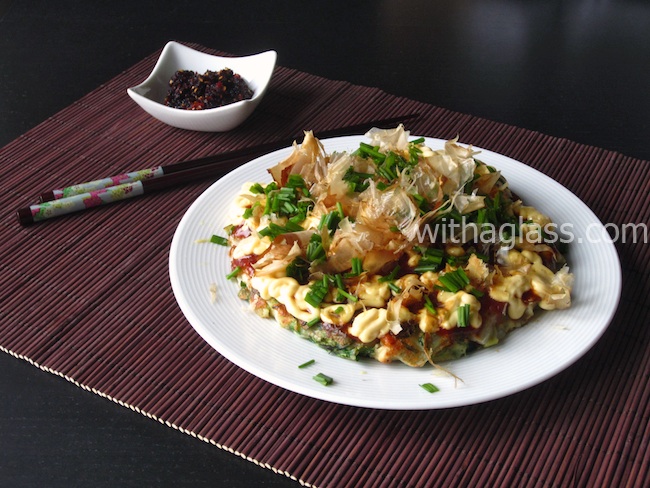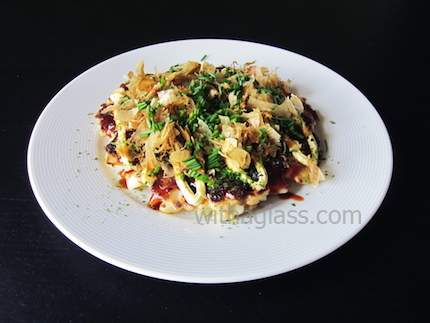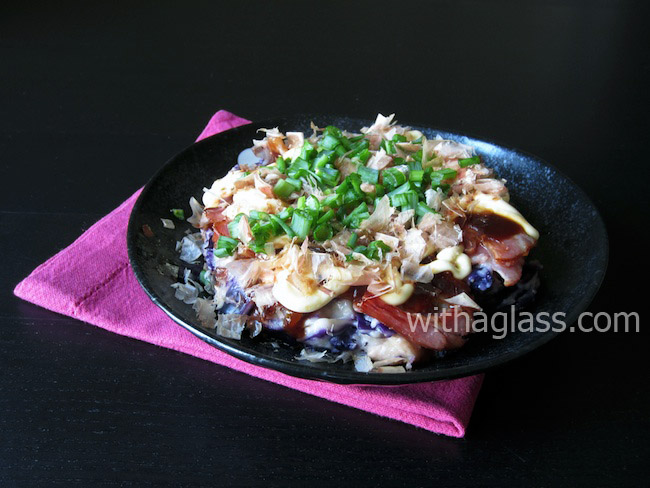Okonomiyaki (Japanese Savoury Pancake) with Bok Choy and Chicken

If you don’t know okonomiyaki yet (I have written about it here and here), I will repeat what I have said in one of my posts: this messy-looking dish is one of the most brilliant inventions of the Japanese cuisine. Easy, quick, versatile and full of flavours, it is a dish one falls in love with at first bite and becomes instantly addicted to. Okonomiyaki (お好み焼き ), often called “Japanese pancake” or “Japanese pizza”, means more or less “grill what you like” (“okonomi” means “what you like/want” and ”yaki” means here “grilled”). In fact, apart from a regular “basis”, different ingredients can be added and okonomiyaki restaurants offer a whole range of versions. I have fallen in love with okonomiyaki at the first bite, it has become the most frequent Japanese dish I prepare and never get tired of it after dozens of meals. I have to say once more that this is one of those Japanese dishes which could become famous and loved all around the world due to its versatile ingredients and the lack of obligatory “exotic” products.
As a reminder, okonomiyaki is composed of three parts: the batter, the filling and the toppings. The batter has two main regional versions: Kansai (Osaka) style, according to which pancake batter is mixed with shredded cabbage, and Hiroshima style, which contains also noodles. I “practice” only the former which is lighter and easier to prepare. Beef, pork, dried shrimp and squid are the most popular ingredients added to the basic mixture, which is formed into a thick circle and fried or grilled. In Japanese restaurants clients grill the mixture of their choice over a smooth teppanyaki grill and I remember my okonomiyaki lunch as lots of fun.
Just before serving, okonomiyaki is topped with different ingredients. My favourite – and now obligatory – are mayonnaise, okonomiyaki sauce (which I prepare with a mixture of ketchup, soy sauce and Worcestershire sauce), katsuobushi (dried shaved bonito, hated by many Westerners) and chives or spring onions. I also like to spice it up, adding hot paste, hot oil, chili bean sauce… Many people serve pickled ginger on top, but I prefer to serve it aside.
Visit Hiroyuki’s Blog on Japanese Cooking, Nami’s Just One Cookbook, Robert-Gilles’s Shizuoka Gourmet, Arudhi’s A Box of Kitchen to learn more about other okonomiyaki versions and Charles’s Five Euro Food to see a very European interpretation.
Since I discovered how to make okonomiyaki (here I must thank once more Hiroyuki, Nami, Robert-Gilles, Arudhi and Charles, who inspired me greatly with their different okonomiyaki versions), I must have prepared at least dozen different permutations (I have posted only two of them: first one with eringi mushrooms, bacon and dried shrimp and another one, with chicken). Nowadays fried pieces of chicken breast are my absolute favourite addition to the batter, although a Japanese friend told me this is unheard of in Japan. Anyway, I can add what I want, can’t I? As for toppings, these never change.
Bok choy, or pak choy (“chingensai” チンゲンサイ in Japanese) is not a traditional okonomiyaki ingredient . I only use it in stir-fries, so my choice of pak choy was purely accidental: it was late and my shop ran out of cabbage, but had beautiful, fresh bok choy. It is softer and much more delicate than white cabbage, therefore I worried it would become mushy and lose its delicate taste. I was wrong of course! Bok choy’s stalks were still slightly crunchy, the taste was subtler and made this okonomiyaki seem lighter and fresher. It was a nice change from the regularly used cabbage and I was glad to discover a new way to use bok choy. Needless to say, if you are familiar with okonomiyaki, I encourage you to try it with bok choy and if you are not, do try preparing any of the versions, such as these:


… with Eringi Mushrooms and bacon

TIPS: Okonomiyaki batter mixture in powder can be bought in Japanese grocery shops or prepared from the scratch. Personally I am happy to prepare it from the scratch since it takes two minutes and I’m sure it tastes better. I have seen different batter recipes. Mine is composed of an egg, flour, dashi (Japanese stock), salt, pepper, baking powder and, last but not least, grated mountain yam (or yamaimo in Japanese), a slimy cousin of the potato (I find it in organic shops but it is sold in Asian groceries too) and I sometimes add a splash of milk. Both yam and dashi are not obligatory. When I don’t have yam or dashi, I simply omit them, trying to keep the same pancake-like texture (milk can be used instead of dashi). The result is still delicious, albeit slightly different.
Okonomioyaki mixture (with the cabbage) can be prepared in advance and fried/grilled the following day. As an addict, I often make a bigger batch and have it two days in a row. (Actually I even had it recently for three meals in a row: a lunch, a dinner and a lunch the following day…).
Special equipment: a big pancake spatula is very useful to flip okonomiyaki
Preparation: 40 minutes
Ingredients (serves 2):
Batter:
5 slightly heaped tablespoons flour
30 ml (about 1 oz) dashi (Japanese stock, home-made or instant) or milk or a mixture of both
1 egg
3 cm/about 1,2 in grated mountain yam (yamaimo) (can be omitted, but then less flour should be added)
salt
1/2 teaspoon baking powder
(pepper)
Filling:
10 bok choy leaves and stalks (or more if the bok choy is small) chopped or finely cubed
1 chicken breast
1 tablespoon oil
Topping:
dried bonito flakes (katsuobushi)
okonomiyaki sauce (or a mixture of ketchup, Worcestershire sauce and soy sauce)
mayonnaise
chopped chives or spring onions
2 tablespoons oil
(chili paste, oil or sauce, such as Taberu Rayu)
(pickled ginger)
Cut up the chicken breast into small cubes (1 cm x 1 cm). Season with salt and pepper, fry until golden brown and put aside.
In a big bowl combine the batter ingredients. Add the filling ingredients and adjust their amount (the mixture should be very thick, not liquid and the batter should only bind the ingredients together and not dominate them).
Heat one tablespoon oil in a frying pan or on a smooth grill (called teppanyaki grill or la plancha).
Put half of the okonomiyaki mixture in a more or less round-shaped heap (you can adjust it on the pan).
Flatten delicately the pancake, but not too much. Otherwise it might fall into pieces when you turn it over. (My okonomiyaki is max. 1,5 cm/about 1/2 inch high)
Cover the pan and let it fry at medium heat for 5 – 10 minutes until you see the upper part of batter set. If you use an old-fashioned pan (steel or iron), you might have to turn down the heat to the lowest because it might burn.
Flip the pancake over, cover once more and fry for another 5 minutes.
Repeat the same with the remaining batter mixture.
Serve topped with (I always do it in this order): okonomiyaki sauce, mayonnaise, dried bonito flakes, chives (or spring onion) and chili sauce/oil or paste or anything you wish.
Ugh! My internet cut out just as I clicked submit (don’t you just hate when that happens?!). Let’s try again.
This looks *so* good Sissi! I remember your gorgeous Japanese pancakes and how different and healthful they are compared to our North American understanding of pancakes. Specifically, I love the emphasis on protein and vegetable over flour. Ooey gooey pancakes have their place 😉 but okonomiyaki is a real food that I would happily introduce to our table for breakfast, lunch or dinner – anytime! Wonderful.
I’m so sorry, Kelly. It also happens to me sometimes… I hate it especially when I have put a long comment (and I’m quite talkative sometimes as you might have noticed 😉 ). Thank you so much for the compliments! Of course I’m not a nutritionist, but this is one of the best meals I know when it comes to feel full and eat something healthy. The batter is there just to bind the cabbage and for example chicken. Of course the toppings depend on one’s preferences, especially their amount… (I buy excellent low-calorie mayonnaise in France, hence such a heap of mayonnaise…).
This is really fascinating Sissi and you made it look so inviting! Am I correct to assume this is comfort food?
Thank you so much, Zsuzsa. Yes, it is comfort food already! It’s an easy way to eat vegetables and for me it was an original way to discover the cabbage (crunchy, but slightly cooked). Bok choy fits here so well (actually I have bought some tonight in my organic shop because I kept on thinking about this post and started to crave this okonomiyaki version…).
I forgot your earlier posts and forgot what okonomiyaki was until I saw it on a site couple of weeks ago. The one I saw was covered with bacon, and it was called Japanese pizza instead of okonomiyaki! I made a note to make okonomiyaki, then I saw this post. Nice reminder, thanks.
Have a nice weekend
Thank you, Mr. Three-Cookies. My two previous recipes have strips of bacon on top (they become crunchy when you flip the pancake, so it’s really delicious). Sometimes, like here, I don’t have bacon, but I always have chicken, so it’s still good. I am sure you would love okonomiyaki!
I prefer to call it pancake, because the batter is closer to a pancake and also it’s fried or grilled, not baked. On the other hand, it’s probably more appetising to call it pizza and it has different topping just like pizza… Difficult decision! Have a nice weekend too! (By the way, I have just bought a big nice bok choy in my organic shop (I’m always thrilled to discover that I can have local organic exotic vegetables instead of ones shipped from Thailand or Vietnam and sprayed with tons of chemical stuff for the trip…) and am planning to prepare this okonomiyaki once more tomorrow: it often happens when I post a recipe and kind comments by visitors make me crave it once again).
Hi Sissi, I bet the bonito flakes danced happily on top of your Japanese pancakes, these look so yummy and healthy!
Hope you have a great weekend, we recently found out the master shower is still leaking after I paid $300 for the repair, looks like it’s inevitable we need to replace the whole thing. So this weekend we will be picking out the materials, construction will begin next week… Ahhh more constructions after so many months of craziness last year… We are looking forward to a new and clean shower though!
Thank you so much, Jeno! I remember we are both fans of dancing bonito flakes 🙂 Of course I love watching them on the plate!
I’m sorry to learn about your shower leak. It seems you are constantly having something repaired or constructed in your house recently. Good luck with the replacement!
Your definition of okonomiyaki is (as always) very well explained! Oh I love Okonomiyaki. We had it not a long ago but I can just pop into okonomiyaki restaurant every week (if I cook every week at home my family will kill me… heheh). What an interesting twist to add komatsuna and chicken! I love how you adapt Japanese recipes and it’s really fun to see because my mind is more set when I think about okonomiyaki. Thanks for the mention, and have a wonderful weekend!
Thank you very much, Nami. I have always thought you were the best at explaining recipes or products, so I’m extremely flattered by your comment. If I had okonomiyaki restaurant around the corner, I would go there all the time. (Doesn’t your family like okonomiyaki?). I have just checked and it’s I think not komatsuna in Japanese… Komatsuna has thinner stalks than bok choy. I thought it was called chingensai… Thank you again for the compliments and have a wonderful weekend too!
Both of these versions sound very tasty. I’m not familiar with the mushroom type you used however. My own version (bacon or shrimp or fake crab legs/surimi as the protein) is more like a pancake with cabbage inside but still tasty. No yam, needless to say. 🙂
Thank you so much, A_Boleyn. Eringi is from the oyster mushroom family (sometimes it’s called king oyster mushroom). It has a very funny shape http://en.wikipedia.org/wiki/Pleurotus_eryngii and even though it has no smell when raw, it becomes fantastic when grilled or fried slightly. It has a meaty consistency and flavour… I remember your version very well! It looked delicious! I was very surprised to see here yam in organic shops; I used to buy it in a Chinese grocery shop before.
Messy looking? Sometimes messy or should we call it more like Down-to-Earth is beautiful and delicious. You actually did a great job plating and photographing this dish. Have a good weekend, Sissi!
Ray, you are really kind. Thank you so much for the compliments! (We have a period now with cloudy days, so since I don’t have any special photo lights, I am not very happy with my photos…). Have a lovely weekend too!
Thanks for showing us another interesting combination. I remember having used Chinese cabbage instead of cabbage once because the latter was way too expensive to buy.
I don’t have a hot plate, so I always use a frying pan. Flipping okomoniyaki with a turner is really tricky, so I use a large plate instead. Slide okonomiyaki onto the plate, and then return it to the frying pan, upside down, in a quick motion.
I sprinkle ao nori first, because the slightest air flow will cause it to scatter about on the table and even on the floor!
Thank you very much, Hiroyuki. I’m very proud to learn that you find my modification interesting. I have a huge pancake turner (round, 15 cm diameter!). I bought it once because it looked cute and original and after a year I discovered it was perfect for okonomiyaki!
I sometimes sprinkle ao nori too (but I usually am so excited about the huge heap of katsuobushi, I tend to forget it! I hope there is no danger of katsuobushi overdose because I have it all the time… I brought about 1 kg from Japan and you know how light it is so imagine the space it took in the luggage!). I must update the post! Thank you for reminding me of ao nori.
Hi Sissi,
am back again…good to see you website going strong…still lovely recipes…I am now back with a company selling jewellery, stoles and bags to begin with…designed and created in India..though my blog will of course be talking about food….
have a great 2013.
Regards
Shilpa
Dear Shilpa, I’m very happy to see you again on the web! Thank you for kind compliments. I am hopping to see the treasures you sell (I love Indian wool stoles!). Good luck with your new activity and thank you for visiting me again! Happy New Year!
It’s like a mini-pizza! I love making recipes like this because of their versatility. Love the chicken, bok choy and all of the other ideas for making this! I’ve been getting into making Indian flatbreads recently, so now I guess it’s time for Japanese flatbreads/pancakes! Thanks for turning me on to these! It looks delicious! Hope you’re having a wonderful weekend!
Thank you so much, MJ. This is definitely easier than any Indian flatbread! No kneading and much quicker to prepare.
I’ve really enjoyed your other Asian pancakes, I’ve made the Korean pancake and loved it. I love how rustic this looks and I know I would enjoy the dashi flakes for sure.
Thank you very much, Eva. I remember you have made a wonderful Korean pancake! This one has much less flour and batter in general.
It is always so much fun to visit and see what wonderful creation you have made.
Thank you so much, Karen, for the compliments.
Dear Sissi!
You are going to start a new trend! LOL
Best regards,
Robert-Gilles
Thank you so much, Robert-Gilles. I’m flattered 🙂 Now that I think…. having okonomiyaki for 99% of my Sunday brunches for at least six months now is already a new trend among non-Japanese people living in Switzerland 😉